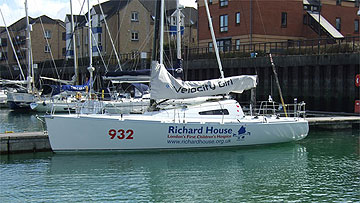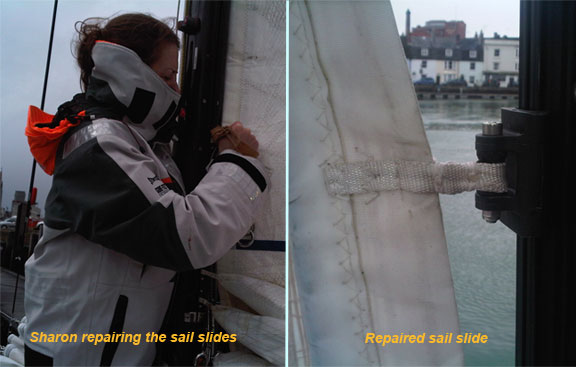

Dateline: 6th April, 2010
‘Richard House’ April Bank Holiday training.
This last weekend Sharon and I planned to sail in two legs to Dartmouth via Weymouth and then back in one go, to Ocean Village on Sunday, 4th April. As with most plans it didn’t quite go that way, and one problem still has me scratching my head as to the cause.
The forecast was for South, South Westerly winds 20 – 26 kts on Friday.
South Westerly, Westerly winds 22 – 27 kts on Saturday.
Westerly winds around 14 kts for the return on Sunday.
It all looked like good winds to give ‘Velocity Girl’ a good early season run out.
We set off from Ocean Village with 60 miles to go for Weymouth on the ebb at
around 1200 hrs expecting a sail-time around 6 – 7 hours.
We put up the No.4 headsail with one reef in the main as we knew the winds would be gusty as 34 kts was occasionally showing on the Bramble Bank anemometer. The wind was also more in the west which meant a beat up the Solent rather than a straight reach in the deeper water with tide. We filled ‘Velocity Girl’s’ 320 ltr ballast tanks to give us extra power and stability upwind.
Once through Hurst Castle and the Needles Channel we were clear away towards St Alban’s Head; we had decided to go wide and avoid the over-falls with the strong wind against tide. As we approached St Alban’s we had our first problem. Over the winter I had adapted the Cunningham to also work as a reefing line by adding a longer line and a snap shackle to clip onto the sail reefing points. This means that once connected to the reefing point VG could be reefed single handed from the safety of the cockpit. I had run the line through the gooseneck; this meant that the line pulled slightly (about 3 inches) in front of the mainsail track which when fitted in the Marina didn’t look a problem.
VG was handling the wind and waves beautiful and with the No.4 the auto pilot was happily keeping her on course. I decided to take out the reef as the wind seemed to have stabilised around 20 kts. As I released the ‘Cunningham’ line, the weight of wind was taken by the first mainsail slider and the tape attaching the slider to the sail gave way. Then the next three gave way in quick succession. We now had a main held to the mast by the top and bottom slider with the whole middle section bust open. Sharon with great commitment held onto the mainsail that was now flogging and would have destroyed itself very quickly without an immediate taking down.
We blew the halyard and fought the main on the deck and tied it up to the boom. This is the sort of incident, mistake, accident that ends races. We could not repair the main in this kind of wind and sea state and notwithstanding that we could also have destroyed the sail and now we could sail only with the foresail. We changed to compass mode on the auto pilot and motored directly to Weymouth. I was reflecting on how even little changes to make life safer and easier can have side effects and everything has to be very carefully thought through.
On Saturday, rather than carry on to Dartmouth we stayed in Weymouth to assess the damage and stitch the slides back on with even stronger braided line. The sail had suffered no damage and I re-worked the Cunningham to run directly up the mast in line with the sail track.

After a lovely meal and a bottle of wine at Vaughan’s Bistro in
Weymouth and very heavy rain overnight we woke on Sunday to a wonderful sunny
day. Wind and tide were going East and back home; the wind was at around 20 +
kts and stronger than forecast but no problem. I planned to try out the smaller
A5 Spinnaker on the spinnaker pole; I had only ever ran the asymmetric A5 from
the bowsprit, but I wanted to see if it’s much flatter shape and smaller size
would work as a deep running sail in strong winds. We have flown our much larger
A2 Spinnaker in up to 26 kts; with VG flying along around 14 kts. The pressure
and chances for a massive wipe-out are too large for a 2 handed crew (certainly
for this 2 handed crew) over any period of time with those sorts of pressures.
First we had to motor out of Weymouth.
I started the engine and the oil warning started to alarm. No problem as the
‘Kingfisher’ Chandlery had relocated and is now right next to the Harbour
Master’s Office where we were moored. I bought 1 ltr of oil and put in about
400mls into the engine. Our engine is Lombardini ‘702’ which produces a mighty
20 hp; the oil capacity is only about 1.5 ltrs and I was about to find out how
critical / sensitive the oil level was.
Now, for an engine to set off an oil alarm, in my experience it must be fairly low, so I thought 400 mls wouldn’t be a problem. However when I re started (for some reason I still haven’t worked out) the starter motor kept engaging. It was as if someone was trying to start the engine whilst it was running, if you have ever done this in a car you will know the sound I mean. I tried the engine a couple of times, felt the starter motor which was getting really hot and judging by the sound I didn’t think the Italian engineering was going to stand much more. I first thought it must be a new problem; but following the simple problem-solving model of ‘was it broken before I started mending it?’ I took out about 100mls of oil; problem solved......... if any mechanics out there can explain how sump oil caused the starter motor to engage I would like to understand this some more.
Engine sorted, we set off and hoisted the A5 at a true wind angle between 140 and 160 degrees. VG took off and maintained 8 – 12 kts all the way to the Needles light. This was wonderful sailing in bright sunshine and smooth seas (wind and tide were together and it can make such a huge difference to sea state). In fact the wind was really up and down between 6 and 24 kts, so we could really get some good info on how the A5 would fly high or low. The A5 worked perfectly between 15 and 24 kts; the boat was so balanced even at 24 kts I felt that with the A5 we could fly the spinnaker up to and beyond the 26kts we had achieved (with great trepidation) on the A2. Below 15 kts the flat shape was unstable and needed to be constantly trimmed. I am satisfied we have the right sail to fly in strong winds or through the night if we are unhappy to keep the A2 up in the dark on a breezy night during the RBI.
As we approached the Needles we heard a May Day from a yacht called ‘Andromeda’ who had run aground on the Shingles Bank. Her skipper calmly put out the message and informed the Coast Guard he was taking on water. The Yarmouth Lifeboat and the Helicopter were despatched. At one point the Coastguard asked if she was still taking on water, and the skipper replied with great calmness and poignancy that ‘he was’; the way he said it said so much about his hope for his yacht’s survival that the Coast Guard just replied ‘I understand’.
By the time we got the Hurst Castle the crew were ashore, the lifeboat and helicopter had gone and there was no trace of ‘Andromeda’. Without VHF we would never have known we had just sailed past the scene of such a recent rescue and loss. The waves were breaking quite heavily on the Shingles and I guess the pounding very quickly destroyed her hull. It was such a perfect day for sailing it is hard to appreciate how close disaster lurks.
As we entered the Needles Channel the wind went much lighter for a short period before it veered into North West and strengthened again (it seems so common that the wind goes light before a fairly big change of direction (I guess as the two winds resolve which one will dominate) so we changed to the No.3 headsail and reached all the way up through Hurst Narrows to Lepe Spit before beating back up Southampton Water to Ocean Village. At this point I found out the water ballast pump wasn’t working; a problem to be resolved in the morning. It turned out that the spade connector had come off the back of the fuse panel; what was slightly concerning is that it looked like it had ‘blown off’ as it was discoloured. So I replaced the connector and reduced the fuse size to ensure if there is a problem the fuse definitely gives out first.
We made a short video of ‘VG’ entering the Needles Channel in fairly light winds and then, as she is changed to a No.3 and reaches past Hurst Castle, note how benign and beautiful the conditions are. It is somewhere near Hurst Castle that ‘Andromeda’ was lost only shortly before.
This is viewable on You Tube link: http://www.youtube.com/watch?v=2PfFLHK3X4c
The wind continued to drop as we tacked up Southampton Water in the dark. It was still a magical end to the day as the water was completely calm, all the stars were out and we could just hear the wash of water down her hull.......... and then the Fast Cat came blasting past! We had been fighting the tide since before the Needles due to our late start; those few extra hours of tide against us made a big difference to our journey time, taking an extra couple of hours at 9 hours from Weymouth to Ocean Village.
Before this trip I had been working on ‘VG’ Polars which I have managed to upload into our chart plotter which uses them and the wind information to predict journey times and sailing angles. They proved to be reasonable accurate and if I get time in the evenings will fine tune these some more. I also produced a Sail Crossover chart using Excel; this with the Polar information really helps us understand what angles we should be sailing and where the transitions are between all our upwind and downwind sails. We have laminated and stuck these in the cockpit as a ready guide to help decision making and to keep us focused on best VMGs and sail choices.
Sharon and I learned more about getting the best out of ‘VG’, more about the engine, electronics and sail care. None of the hours afloat are wasted, we both have a lot to learn.
We are hoping to enter the first of the Royal Southampton Yacht Clubs 2-handed races on the 10th April. April and May are both looking incredibly busy at work. It seems we will have to be very careful to ensure we find time to keep preparing ‘VG’ for the race and also to enter some races at the weekend.
June the 6th is approaching fast, I am glad we managed to expose a few more problems this weekend; hopefully the more we can push her now the stronger she and we will be during the Round Britain Yacht Race, boat maintenance and preparation is a lot like '3 up and 2 down'.
Richard & Sharon
6th April, 2010.